South Africa Part 2 History And Final Thoughts
No trip to South Africa can avoid the harsh realities of its troubled racial history. You are confronted with echoes of Apartheid all over the country. Coincidentally back home, there were Nazis marching in Charlottesville and one domestic terrorist drove a vehicle into protesters, killing a woman. Knowing the US racial history and the undercurrents of systemic racism still present in our society and the latent racism emboldened by our white supremacist embarrassment-in-chief, Trump, I couldn’t help but wonder about similar latent racism and hostilities in South Africa. It also gave me pause about the moral implications of our kids learning and speaking the language (Afrikaans) of the historical colonial oppressors. We ended up just speaking English, which is the most widely spoken language.
Cape Town itself was explicitly designed by the Apartheid regime to segregate the physical space along racial lines. You can see this still in place today just driving around the city, but you can see it even more clearly from the air.
“Points of contact invariably produce friction and friction generates heat and may lead to a conflagration. It is our duty therefore to reduce these points of contact to the absolute minimum which public opinion is prepared to accept.” – T.E. Tonges, 1950
We never got to personally tour any of the townships, but we drove past several and the difference from the white, affluent neighborhoods was stark and saddening. The biggest contrast was seeing a pilates studio and upscale boutiques, cafes and food shops directly across the street from one of the townships.
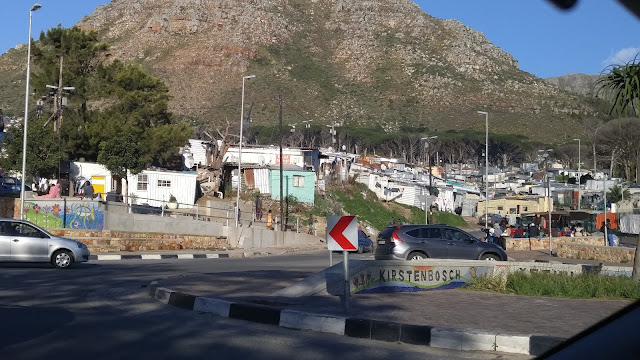
Imizamo Yethu Township near where we stayed
Soon after arriving in Cape Town, we made a trip to the District Six museum to learn about some of the horrors of Apartheid. This was something we were really interested in understanding more. I only knew of it a little from my childhood when the protests were going worldwide in the final years of the Apartheid regime. You hear first-hand from someone displaced by the Apartheid policies from District Six about what it was like. She was just a child and her family held firm for many years before finally being forcefully evicted and moved to somewhere they didn’t know with very few worldly possessions. Her mother died very shortly after losing their home and she still attributes it to death of a broken heart. There were actual artifacts from the Apartheid era and lots and lots of personal stories of what life was like in the District before everyone was forced to move out. It was moving to read about how vibrant the community was prior to forced relocation. There was a local cinema where people would gather and even bring in their own food to eat during films. There was a public bath house where people gathered to do the wash. A lively jazz scene and other signs of normal community life that were destroyed by Apartheid.
One especially moving display were actual signs and benches that were “whites only” We had similar things in parts of America during our days of segregation, but I had only seen pictures of those in books. To me, they had been merely a black and white photo in a school history book about a long ago time, far away from where I grew up in Washington state. To see them in-person and from oppression in another country, it was impossible to avoid a sense of what life was like for the oppressed in those dark times.

One of several tapestries former District residents wrote messages on, now preserved by embroidery. Some quotes below.
“Happy Days District Six living was cheap, life precious. Now in Hanover Park, living’s expensive and life is cheap.”
“I’d love to come back. I remember the love of my friends and family. We don’t have that where we stay now.”

Hopeful message on a map of District Six before forced relocation
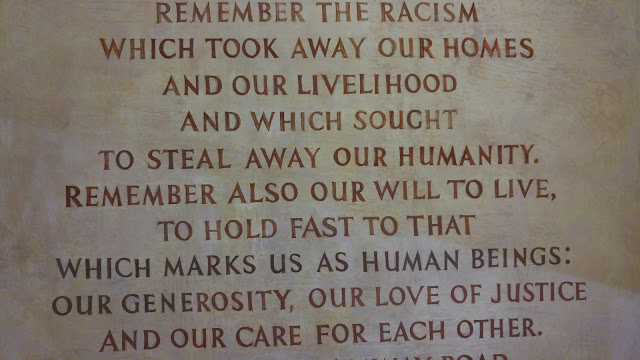
Hopeful quote on an exhibit at the District Six museum
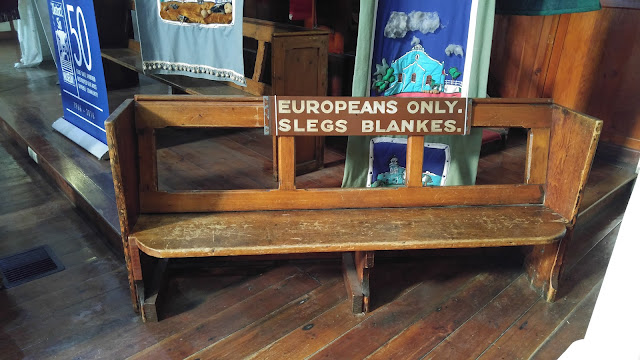
Europeans (whites) Only Bench
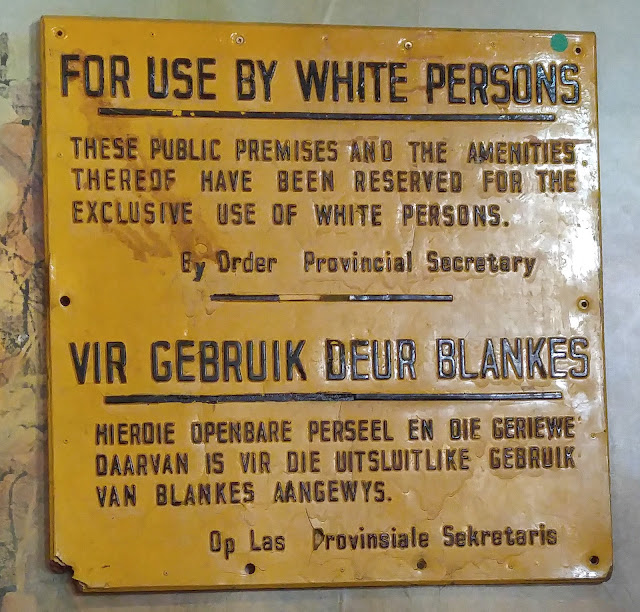
For Use By White Persons sign
Robben Island is an island off the downtown shores of Cape Town that has a sordid past. It had been used for hundreds of years as a place to banish political prisoners, the sick, lepers, mentally ill, and other undesirables. The Apartheid government re-opened it as a maximum security prison for its common criminals and growing list of political prisoners, most famous of which was Nelson Mandela. Mandela was imprisoned there for 18 years of his sentence. Touring the island and prison was another way we were hoping to learn and teach the kids more about Mandela and the impacts of Apartheid.
The tour was given by an actual former political prisoner, so you heard first-hand what life was like and heard some stories that reminded me of the show Hogan’s Heroes. Mandela had used the courtyard (pictured below) to bury portions of the manuscript of his famous book, The Long Walk To Freedom. We also heard about how they would play tennis in the yard and secretly toss the ball over the wall to send messages to new inmates (the ball had been cut open to hide messages inside).
Life was very hard at the prison. Many were required to do forced hard labor in dangerous conditions that ruined their eyesight and lungs. The most dangerous (to the white establishment, i.e. famous and powerful) political prisoners were kept inside the courtyard and crushed rocks there all day long. Many endured conditions that violated international standards of prisons and when inspectors came, all had to put on a good show to pretend things were better than they were. International inspections and pressure did result in some prisoners getting beds so they didn’t have to sleep on the floor.
I asked our tour guide afterward whether there was any justice for those who were responsible for Apartheid and he told me about the Truth ad Reconciliation Commission that attempted to pave a way forward and air out in the open the wrongs and provide a process for prosecuting the major offenders, but also for amnesty of some. It sounded too good to be true, and it appears as if the results were controversial.
The tour ends poignantly a ways from the prison exit so you get to experience for yourself your own “Long Walk to Freedom” through the gates that many prisoners were eventually fortunate enough to experience as international and local pressure chipped away at Apartheid.
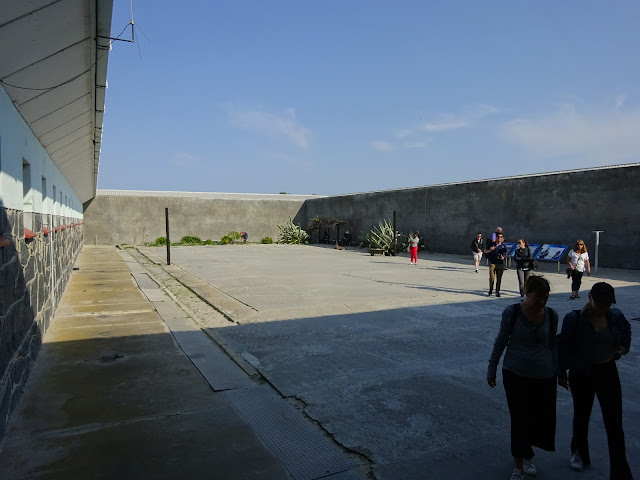
Yard where political prisoners spent their days on Robben Island and covertly communicated and hid manuscripts

Nelson Mandela’s Cell On Robben Island
Income inequality is impossible to ignore in Cape Town and is one of the biggest contrasts with the backdrop of such amazing beauty of the countryside. Everywhere you go, there are people performing all kinds of even menial service jobs for the prospect of a small tip. Parking lot attendants, car guards, gas station attendants, etc. were everywhere. Some were sanctioned (with official safety vests and everything) and others were more–opportunistic or entrepreneurial. You would park on a city street for free and have someone essentially shake you down for small change for watching your car when you leave. This was something that we never really got used to. It must be a constant reminder to any local residents with any heart about the differences between the haves and have-nots and how much more needs to be done to address these problems. Cape Town’s unemployment rate reached a staggering 14-year high of 27.7% this year so it is not surprising many were finding creative ways to make ends meet.

Establishments trying to avoid being part of the tipping culture pervading South Africa.
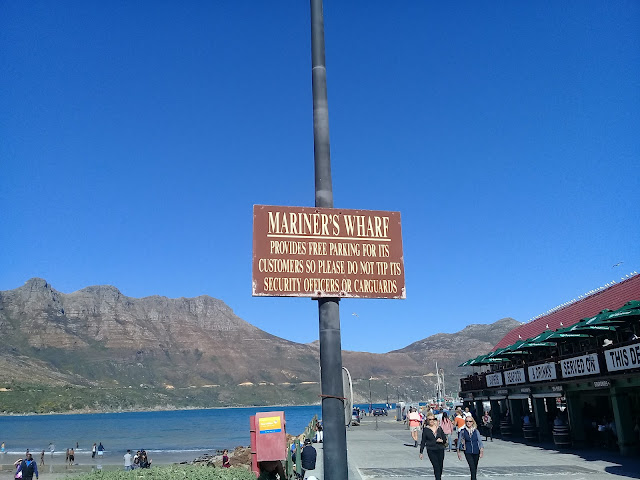
A popular tourist location in Hout Bay trying to avoid predatory car guard entrepreneurs.
I couldn’t help but imagine Seattle heading in the same direction as Cape Town. Housing has gotten so expensive in Seattle that it has pushed lower-income residents out of the market. And Seattle happens to have 51% of residents making $50,000 or less. The city is trying to address the problem with a new tax on wealthy households that will fund low-income housing. We certainly don’t want Seattle to become a place only for wealthy tech workers.
One troubling thing we saw a lot in South Africa were children performing for money. We saw them at Camp’s Bay Beach and other popular, upscale locations. The picture below was taken where our Bo Kaap tour started. The kid dances were entertaining, but I couldn’t help but worry about them being trapped in a cycle of poverty if we supported them. It was worrying enough that we saw the sorry state of the South Africa public library. No Wi-Fi access, but at least they had computers with Internet on-site. And really a lack of variety of books. The books that were there had seen better days as well. It made us appreciate our Seattle public library all the more. But it makes me sad to think about the impact on literacy and education that such a lack of reading material availability presents and that this may further keep many in the population from reaching their full potential. Hopefully, school libraries are better stocked.
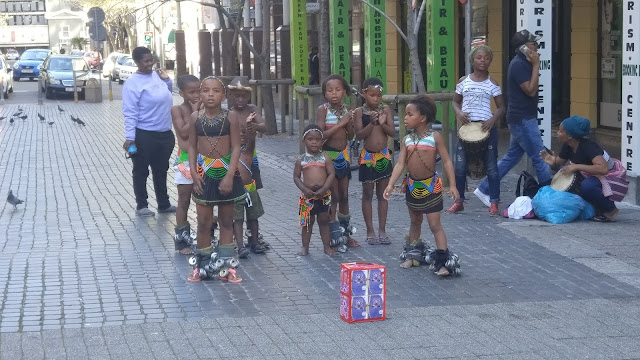
One of many groups of kids and mothers we encountered dancing to earn money.
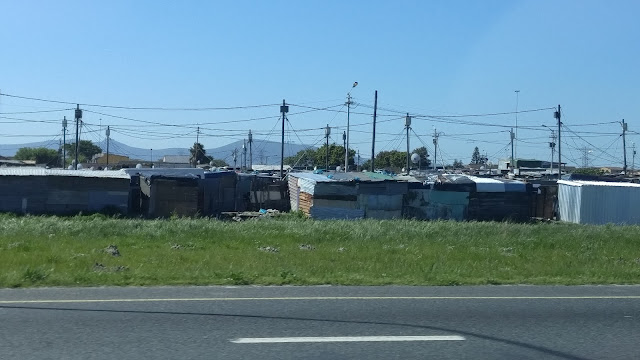
A township we passed along the garden route drive.
Bo Kaap is a picturesque part of town whose name is Afrikaans for “Upper Cape” It also has a rich past. Its residents are primarily Muslims and it is home to a 216 year-old mosque and many others. The ancestors of many residents were freed slaves and laborers that had been brought to South Africa from all over (east Africa, Sri Lanka, the Dutch East Indies) but retained their culture and heritage and keep a lot to this very day. It is the home of the wonderful and famous “Cape Malay” cuisine, but it’s a misnomer to refer to the residents as “Malay” since they were brought from all over. The colorful painting of the houses is a relatively recent evolution that ties to the region’s Muslim heritage. We found that some of the colors were actually a kind of code. Purple houses were places where cooking classes are held, for example.
Due to the popularity of the area, real estate prices have surged. And our tour guide told us about efforts to prevent buyout from outside investors or wealthy individuals that would result in destroying the cultural heritage of the neighborhood that is actually a core reason for its popularity. It’s a tricky problem though because it reinforces the segregation of people and cultures into separate districts that is already endemic by design in Cape Town.
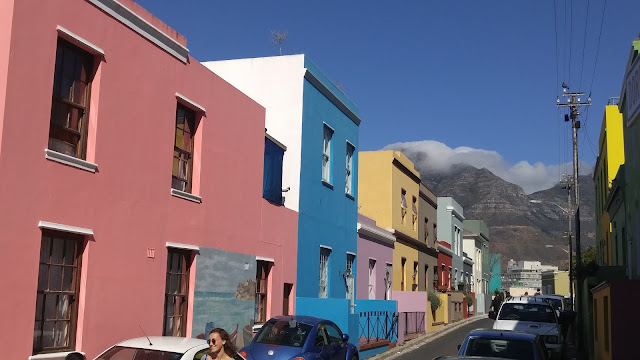

You can see why this area is so popular. Great views of Table Mountain as a backdrop for technicolor facades.

Cape Town is steeped in history but we only began to scratch the surface. It is still a victim of its own past and trying to right some of the wrongs by providing millions of new houses to those on the low-income scale, but this may still perpetuate racial divides as well,
But these have come with their own problems: despite the improvements in individual living conditions, there is a growing realisation that the RDP housing programme has reinforced apartheid era segregation, continuing to consign the poor to ghettos at the furthest edges of the city [1]
They have only had a couple decades to turn things around though. Hopefully they can continue fighting for solutions that will enable everyone in South Africa to participate fully in society and enjoy the beautiful country as much as we did.